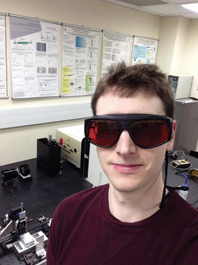New Year tips for last minute presentations
7 Jan 2019 by Evoluted New Media
Forget that resolution to start completing tasks well in advance – just get really good at doing them last minute says Dr Matthew Partridge as he gives us his New Year tips for preparing last minute presentations.
In previous years I’ve always started the year with an article on how to keep your research resolutions. But the majority of us that understand that, really, resolutions – especially those that promise to be more efficient – only last the short interval between midnight on December the 31st and the first deadline that we complete with 5 mins to spare.
I for example have long resolved to stop writing my presentations late and do them well in advance. The presentation I gave the day before writing this was written with an hour to spare. As a resolution it’s not exactly sticking.
So, as keeping resolutions is really not in my skill set I thought it better to share my other expertise, in preparing last minute presentations. The flowing steps will help guide you though how to write a presentation that should have taken you several hours, in jut a few minutes.
The first step is find out what the title was. If you’ve managed to forget the deadline for the presentation there is a good chance you’ve also forgotten the title you agreed to give. Of course you could e-mail the organiser and ask but it’s best to not involve them, getting “hey that talk I’m giving in an hour… what’s it on” from one of your presenters is a bit stressful.
If you can’t find your title then don’t worry, just make one up that sounds right and then when you start say “You might notice a title change but I decided that this better fits with what I’m going to show you”. Though it is important to stay on subject, don’t change it to “my holidays” when you were supposed to be doing “Quantum Optics with non-linear entrapment”… unless your holidays were at CERN.
Next you need to actually make the presentation. There are two ways to do this; the frankenstein, or smoke and mirrors.
The frankenstein method is my preferred option. You simply take slides from previous presentations and copy and paste them in some kind of sensible order in a new presentation. If you’re feeling really fancy you could even make a couple of slides to make things stitch together but this is pretty optional. Frankenstein slides can be very quick and despite the name won’t require some questionable electrics and a secretary called Igor.? 
The frankenstein method does have the downside that your slides will look like an ill fitting mess of formatting and templates. For some people this won’t actually be any different to their normal artistic style but it will make it challenging to look at. It does also require you to have at some point made some slides. But if you don’t have any at all, then you can always try the smoke and mirrors method.
The basic aim of the smoke and mirrors method?is to make slides that are both vapid and confusing so that no one quite realises that there is no real content. You want slides that look so complicated to understand that no one will try.
You’ll need to start with a blank presentation, preferably not in the correct template, then start adding some text and?every graph you have. You need to litter the text with technical terms and buzzwords in order to get to at least 200 words per slide. The graphs need to be small and preferably in groups of at least 7 per slide. Lastly you need to have at least 5 slides showing only windings and mathematical symbols.
There’s an art to preparing slides confusing enough to pass for a real presentation but if you want examples just watch a couple of talks at an academic conference, they are all masters at this. Many of them are so modest that they’ll deny it but their slides are some of the best nonsensical slides ever seen in a conference room.
Lastly you’ll need to present it! Like all presentations stand facing the audience, speak clearly and try very hard to not looked surprised every time you change slides.
Author:
[caption id="attachment_83608" align="alignnone" width="170"] Dr Matthew Partridge is a senior Research Fellow at the Optoelectronics Research Centre at the University of Southampton but describes himself as a biochemist who has accidentally ended up working with optical sensor systems.[/caption]
Dr Matthew Partridge is a senior Research Fellow at the Optoelectronics Research Centre at the University of Southampton but describes himself as a biochemist who has accidentally ended up working with optical sensor systems.[/caption]









